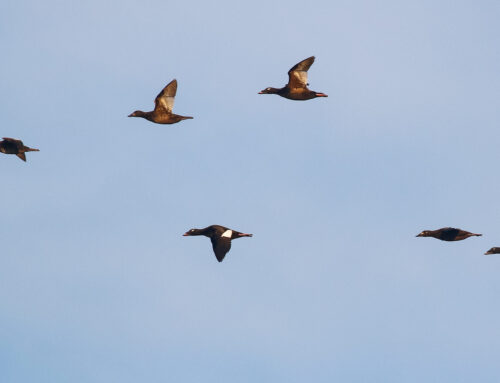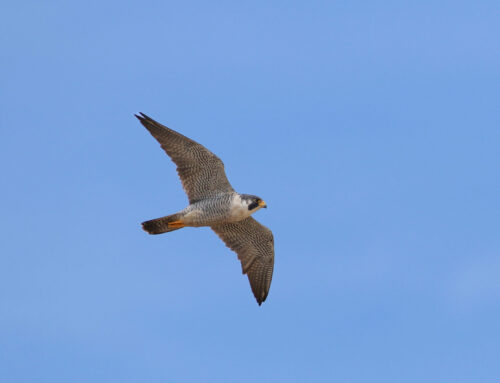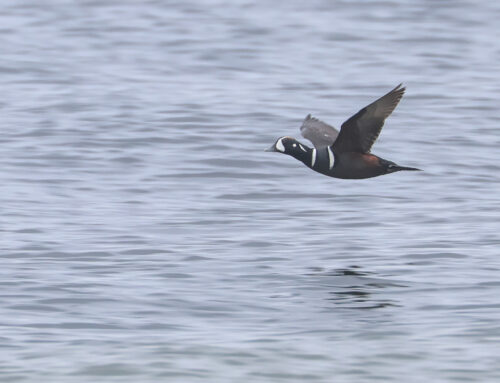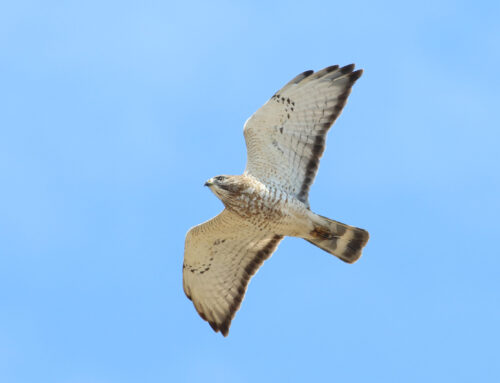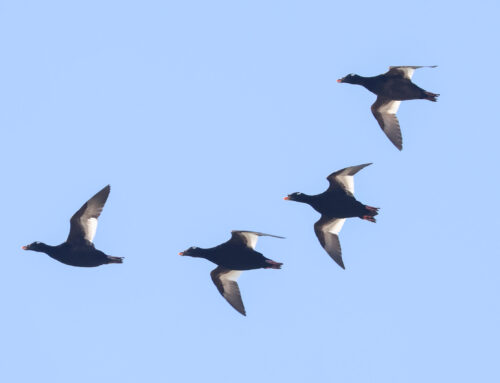A surprise for many visitors to the waterbird count is how distant the birds are. While the handful of loons that pass overhead and chickadees that venture inside the waterbird shack defy this statement, they are few compared to the thousands of birds flying a quarter mile or more from the shoreline. How we identify these birds relies on a particular approach, one that can greatly enrich your experience at Whitefish Point.
Field guides often depict waterbirds doing what waterbirds spend most of their time doing: sitting on the water. From this angle, a suite a field marks present themselves to aid you in your quest for a positive identification. Some field guides will show you the bird in flight with corresponding attributes, which are invaluable to watching migrating waterbirds. These are essential resources, but sea-watching (in our case, lake-watching) demands a different approach to identification.
To put it simply, at the distance we observe waterbirds many of the characteristic plumage traits are not noticeable. While you may know the color of every feather of resting scaup, you’ll need a different method for identifying them in flight at distance. Instead of looking for the sheen of their head-feathers, we look for how quick they beat their wings and how deeply they do so. Do they typically hold their wings flat out from their body, or do they bend them sharply at their wrist? When they fly by are they in orderly lines like Red-breasted Merganser or a chaotic ball like teals? Are they chunky and round-bodied like a black duck, or lean and elegant like a pintail? The smooth wing-beats of a scoter contrast greatly with the frantic flight of a grebe. If you’ve ever seen a Parasitic Jaeger in pursuit, it’s hard to forget how characteristic this flight can be. The diving ducks on the whole are much more compact than the dabbling ducks, and the geese much more elongated. All these details help narrow down the possibilities and get us closer to knowing what we’re witnessing. With that said, I’d like to share with you a step-based approach to figuring out distant waterbirds in flight:
- Relative Size: Lucky for us, many waterbirds move in flocks of multiple species. While objective size is not accurately observable, we can compare the birds to each other in order to get started. Teals are smaller than wigeons which are smaller than Mallards, for example.
- Structure: At distance, this is the most observable trait in waterbirds. Is the bird long- or short-winged; streamlined or stout; does it have a long-neck, a large bill, or trailing feet? The long-winged and large-billed shoveler contrasts greatly with the upright-postured Horned Grebe with its dangling feet.
- Flight Style and Flock Structure: We can all recall the “V” formations of geese passing overhead. How waterbirds arrange themselves can be characteristic: be it the high-flying loons or the Bufflehead that skim the water, how the group carries itself can be indicative.
- Overall Coloration: While the exact plumage at distance is unnoticeable, color pattern often is. If the bird has large sections of white, such as the shoulder patches on male wigeon, this can stand out at large distances. If the white is on the trailing edge of the wing, such as with White-winged Scoter, it can look like part of the wing is missing at distance with a light background. You wouldn’t see this in the other species of scoters.
- Association and Probability: With some observation and study you’ll pick up on which birds tend to fly together and how. It’s not uncommon to see a hefty American Black Duck leading the charge ahead of a ball of teal. Location and timing are a strong determining factor for identification with all birds; where you are and when can narrow down the species you can expect to see. With that said, birds break these rules frequently and offer us surprising glimpses of vagrants.
Of course, this can be daunting and it sounds very different from other approaches to bird identification. While this is pointedly true with migrating waterbirds, we do utilize this approach in many other identifications. Think of seeing a shadow of a Palm Warbler pumping its tail, or a Brown Creeper scooting up the trunk of a tree. We all can notice how the distinctive flight of a hummingbird and the bat-like flight of a Merlin differ. Groupings relate to land birds as well, think of the active flocks of chickadees marauding your neighborhood compared to the typically solitary kingfishers.
Identifying birds is our job, but knowing birds is our pleasure. All these pieces of information paint a more comprehensive picture of the waterbirds we’re seeing. Not simply what they look like, but elements of how they act and who they are enter the picture. This knowledge leads to understanding, and that understanding is a connection. While the never-ending variations of avian plumage enthrall us, there is so much more to notice that continues to enrich our experiences with birds.
Text by Fall Waterbird Counter Steve Backus
Featured image: White-winged Scoter. Photo by Alison Vilag
P.S. If you’d like to sharpen your waterbird identification skills, or prepare yourself for a fulfilling visit to the count, I’d highly suggest watching Alison Vilag’s webinar on this topic. The best-written resource is the Peterson Reference Guide to Seawatching. I consult this book regularly and often.


